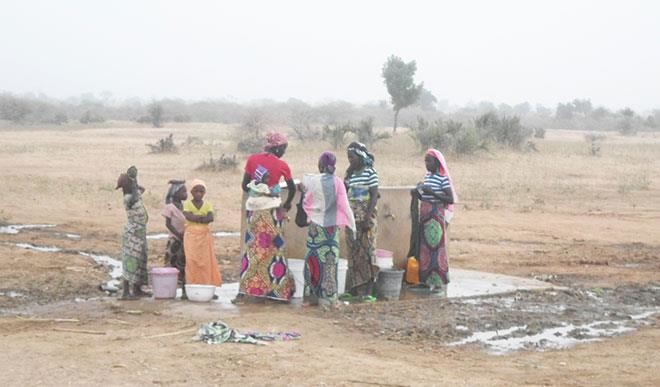
Even before the advent of the Great Green Wall initiative in Nigeria, Katsina State was vigorously struggling to combat desertification and soil degradation from its territorial edifice. Thus, it is a bit difficult to create a line of distinction between the state government’s afforestation projects and NGGW’s effort to curtail the menace of desertification, land degradation and climate change. This is simply because each and every local government in the state has a department of forestry, which was saddled with the responsibility of tackling erosion and desertification. Also, NGOs, International donors and Millennium Development Goals’ projects are all working towards achieving a common goal of environmental protection.
However, in order to ascertain the viability of the National Great Green Wall Agency projects in the state, this reporter toured two local government areas of the state: Batsari and Jibia.
In Batsari LGA, I was conducted round the nurseries funded by the NGGW agency, by Malam Sani Batsari, a staff of the Primary Health Care Centre, Wagini. My guide, who is also engaged in irrigation farming, told me that many people expressed gratitude to the government at the time of distribution of plants and seedling by the agency.
“The agency funded a nursery which was functional between August and September, owing to which a number of plants were distributed to farmers through the ward and village heads. And most of the plants were economic trees, including moringa, mangoes and the like,” he said.
He said: “The benefit is glaringly clear, as the plants would help in no small measure in curbing desert encroachment and benefit our teeming populace economically, since at the end of the day many people will start selling fruits planted in their orchards.”
But the reality on ground is that all that remains from the nurseries funded by the agency in Batsari LGA now is the remnants of plastic polythene bags used in manning the growth of seedlings. And unlike other places where the agency constructs overhead tanks and solar-powered boreholes, one could not even see the billboard indicating the activities of the National Great Green Wall Agency in the local government area.
Another case in point, a number of farmers complained that they were given neither plants, nor seedlings to be used in shielding their farmlands against the menace of desert encroachment. Infact, my guide, who testified to the viability of the project in the local government, told me that he was not given a single plant seedling, he was into irrigation farming.
Another irrigation farmer, Malam Abubakar Tukur, lamented that the plants grown at his Kimbitsawa village were evacuated for distribution in other wards.
“I was told to go and collect some plants to be used in shielding my farm against desert encroachment but up to now, I am yet to get my share, as the officials incharge of the distribution were often seen in the villages of Batsari local government in their Hilux van,” said another irrigation farmer, Alhaji Bashir Direba.
As a matter of fact, inspite of the hitches noted here and there in Batsari local government, the NGGW agency is able to strongly establish its presence in Jibia Local Government Area.
Every keen observer in the local government will notice the viability of the NGGW’s project, most especially at Mallamawa and Kusa villages.
At Mallamawa village I had a discussion with Nasiru Rabi’u, the security guard of NGGW’s facility constructed in the area. “People of my village are busy fetching water for their domestic use. And as you could see for yourself my people are really happy with this overhead tank and solar powered borehole,” he said the security guard.
To cut a long story short, the National Agency for Great Green Wall has to contend with three major problems bedeviling the rural communities in Katsina State, which include: bush burning, indiscriminate felling of trees, inadequate distribution of plant seedlings, lack of solar-powered boreholes and overhead tanks to irrigate the planted seedlings.
In spite of the noticeable problems associated with the initiative, the Great Green Wall project is viable in Katsina State.
Now, it is over year when the Great Green Wall initiative programme of Sahara Sheltert belt was launched in Katsina. And sometimes in July last year, during the launching, former governor of the state, Barrister Ibrahim Shehu Shema, was quoted as saying:
“The state government has spent more than N600 million on environment-protection related programme, adding that as a way of protecting the environment, the state has about 48 nurseries and raises over 2.5 million seedlings annually which are distributed for free to farmers for onward planting.”
Though we need to be prudent in our spending, but it is most certain that people living in the vulnerably affected areas, would like the Governor Masari led state government to sustain all environmental protection programmes. Also, there is a strong need on the part of the people to reciprocate the government effort by watering and replanting their seedling ion order to complement the giant stride of the NGGW initiative in the state. By and lar4ge if what the agency is currently doing in Jibia is replicated in Daura axis, including Mai’aduwa, Baure and Zango , the state would be a role model among the 11 frontline states battling with the challenges of desertification and soil degradation.

 Join Daily Trust WhatsApp Community For Quick Access To News and Happenings Around You.
Join Daily Trust WhatsApp Community For Quick Access To News and Happenings Around You.


